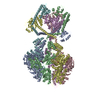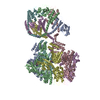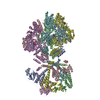+Search query
-Structure paper
| Title | Polyphosphate and tyrosine phosphorylation in the N-terminal domain of the human mitochondrial Lon protease disrupts its functions. |
|---|---|
| Journal, issue, pages | Sci Rep, Vol. 14, Issue 1, Page 9923, Year 2024 |
| Publish date | Apr 30, 2024 |
 Authors Authors | Nina Kunová / Gabriela Ondrovičová / Jacob A Bauer / Veronika Krajčovičová / Matyáš Pinkas / Barbora Stojkovičová / Henrieta Havalová / Veronika Lukáčová / Lenka Kohútová / Július Košťan / Lucia Martináková / Peter Baráth / Jiří Nováček / Sebastian Zoll / Sami Kereϊche / Eva Kutejová / Vladimír Pevala /    |
| PubMed Abstract | Phosphorylation plays a crucial role in the regulation of many fundamental cellular processes. Phosphorylation levels are increased in many cancer cells where they may promote changes in ...Phosphorylation plays a crucial role in the regulation of many fundamental cellular processes. Phosphorylation levels are increased in many cancer cells where they may promote changes in mitochondrial homeostasis. Proteomic studies on various types of cancer identified 17 phosphorylation sites within the human ATP-dependent protease Lon, which degrades misfolded, unassembled and oxidatively damaged proteins in mitochondria. Most of these sites were found in Lon's N-terminal (NTD) and ATPase domains, though little is known about the effects on their function. By combining the biochemical and cryo-electron microscopy studies, we show the effect of Tyr186 and Tyr394 phosphorylations in Lon's NTD, which greatly reduce all Lon activities without affecting its ability to bind substrates or perturbing its tertiary structure. A substantial reduction in Lon's activities is also observed in the presence of polyphosphate, whose amount significantly increases in cancer cells. Our study thus provides an insight into the possible fine-tuning of Lon activities in human diseases, which highlights Lon's importance in maintaining proteostasis in mitochondria. |
 External links External links |  Sci Rep / Sci Rep /  PubMed:38688959 / PubMed:38688959 /  PubMed Central PubMed Central |
| Methods | EM (single particle) |
| Resolution | 2.88 - 8.47 Å |
| Structure data | EMDB-16915, PDB-8ojl: EMDB-16923, PDB-8oka: EMDB-16970, PDB-8om7: EMDB-17213, PDB-8ovf: EMDB-17214, PDB-8ovg: |
| Chemicals |  ChemComp-ADP: |
| Source |
|
 Keywords Keywords | HYDROLASE / Human mitochondrial AAA+ protease / motor protein |
 Movie
Movie Controller
Controller Structure viewers
Structure viewers About Yorodumi Papers
About Yorodumi Papers













 homo sapiens (human)
homo sapiens (human)